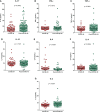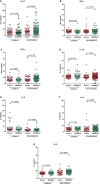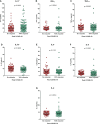Cytokine Profiles Associated With Acute COVID-19 and Long COVID-19 Syndrome
- PMID: 35846757
- PMCID: PMC9279918
- DOI: 10.3389/fcimb.2022.922422
Cytokine Profiles Associated With Acute COVID-19 and Long COVID-19 Syndrome
Abstract
The duration and severity of COVID-19 are related to age, comorbidities, and cytokine synthesis. This study evaluated the impact of these factors on patients with clinical presentations of COVID-19 in a Brazilian cohort. A total of 317 patients diagnosed with COVID-19 were included; cases were distributed according to clinical status as severe (n=91), moderate (n=56) and mild (n=170). Of these patients, 92 had acute COVID-19 at sample collection, 90 had already recovered from COVID-19 without sequelae, and 135 had sequelae (long COVID syndrome). In the acute COVID-19 group, patients with the severe form had higher IL-6 levels (p=0.0260). In the post-COVID-19 group, there was no significant difference in cytokine levels between groups with different clinical conditions. In the acute COVID-19 group, younger patients had higher levels of TNF-α, and patients without comorbidities had higher levels of TNF-α, IL-4 and IL-2 (p<0.05). In contrast, patients over age 60 with comorbidities had higher levels of IL-6. In the post-COVID-19 group, subjects with long COVID-19 had higher levels of IL-17 and IL-2 (p<0.05), and subjects without sequelae had higher levels of IL-10, IL-6 and IL- 4 (p<0.05). Our results suggest that advanced age, comorbidities and elevated serum IL-6 levels are associated with severe COVID-19 and are good markers to differentiate severe from mild cases. Furthermore, high serum levels of IL-17 and IL-2 and low levels of IL-4 and IL-10 appear to constitute a cytokine profile of long COVID-19, and these markers are potential targets for COVID-19 treatment and prevention strategies.
Keywords: COVID-19; SARS-CoV-2; cytokines; long COVID-19; risk factor.
Copyright © 2022 Queiroz, Neves, Lima, Lopes, Torres, Vallinoto, Bichara, Santos, de Brito, da Silva, Leite, da Costa, Viana, Rodrigues, de Sarges, Cantanhede, da Silva, Bichara, Berg, Veríssimo, Carvalho, Henriques, Santos, Nunes, Costa, Viana, Carneiro, Palacios, Quaresma, Brasil-Costa, Santos, Falcão and Vallinoto.
Conflict of interest statement
The authors declare that the research was conducted in the absence of any commercial or financial relationships that could be construed as a potential conflict of interest.
Figures





References
-
- Bergamaschi L., Mescia F., Turner L., Hanson A. L., Kotagiri P., Dunmore B. J., et al. . (2021). Longitudinal Analysis Reveals That Delayed Bystander CD8+ T Cell Activation and Early Immune Pathology Distinguish Severe COVID-19 From Mild Disease. Immunity 54, 1257–1275. doi: 10.1016/j.immuni.2021.05.010 - DOI - PMC - PubMed
-
- Bichara C. D. A., da Silva Graça Amoras E., Vaz G. L., da Silva Torres M. K., Queiroz M. A. F., do Amaral I. P. C., et al. . (2021. b). Dynamics of Anti-SARS-CoV-2 IgG Antibodies Post-COVID-19 in a Brazilian Amazon Population. BMC Infect. Dis. 21, 443. doi: 10.1186/s12879-021-06156-x - DOI - PMC - PubMed
Publication types
MeSH terms
Substances
LinkOut - more resources
Full Text Sources
Medical
Miscellaneous

